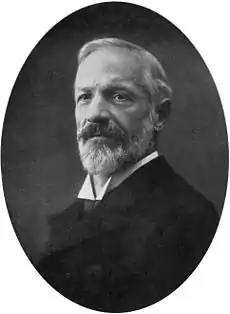Hans Chiari
Hans Chiari (4 September 1851 − 6 May 1916) was an Austrian pathologist who was a native of Vienna. He was the son of gynecologist Johann Baptist Chiari (1817–1854), and brother to rhinolaryngologist Ottokar Chiari (1853–1918).
Hans Chiari | |
|---|---|
 Hans Chiari | |
| Born | 4 September 1851 |
| Died | 6 May 1916 (aged 64) |
| Nationality | Austrian |
| Known for | Arnold–Chiari malformation Budd–Chiari syndrome Chiari Network |
| Scientific career | |
| Fields | Pathology |
| Influences | Karl Freiherr von Rokitansky Richard Ladislaus Heschl |
Biography
Chiari studied medicine in Vienna, where he was an assistant to Karl Freiherr von Rokitansky (1804–1878) and Richard Ladislaus Heschl (1824–1881). In 1878 he received his habilitation in pathological anatomy, and within a few years became an associate professor at the University of Prague. At Prague he was also superintendent of the pathological-anatomical museum. In 1906 he relocated to the University of Strasbourg as a professor of pathological anatomy.
Chiari's research dealt largely with postmortem examinations, and most of his numerous writings are the result of autopsies. In the 1890s he described a condition involving deformities of the cerebellum, and brainstem in children with herniation of the spinal cord.[1] The phenomenon was later to become known as the "Arnold–Chiari malformation", named after Chiari and German pathologist, Julius Arnold (1835–1915). The malformation was given its name in 1907 by two of Dr. Arnold's students.[2]
Another medical term named after Chiari is the Budd–Chiari syndrome, which is ascites and cirrhosis of the liver caused by an obstruction of the hepatic veins due to a blood clot. It is named in conjunction with British physician George Budd (1808–1882).[3] Lastly, Chiari is also famous for describing the "Chiari network", an embryonic remnant found in the right atrium, first published in 1897.[4]
Publications
- "Über Veränderungen des Kleinhirns infolge von Hydrocephalie des Grosshirns", Deutsche medicinische Wochenschrift, Berlin, 1891, 17: 1172–1175 – On cerebellar changes caused by hydrocephalus of the cerebrum.
- "Über Veränderungen des Kleinhirns, der Pons und der Medulla oblongata, infolge von congenitaler Hydrocephalie des Grosshirns", Denkschriften der Akademie der Wissenschaften in Wien, 1895, 63: 71. – On changes to the cerebellum, pons and the medulla oblongata, caused by hydrocephalus of the cerebrum.[1]
See also
References
- Loukas, Marios; Noordeh Nima; Shoja Mohammadali M; Pugh Jeffrey; Oakes W Jerry; Tubbs R Shane (March 2008). "Hans Chiari (1851–1916)". Child's Nervous System. 24 (3): 407–9. doi:10.1007/s00381-007-0535-y. PMID 18066558.
- Arnett, Bridgette (June 2003). "Arnold–Chiari malformation". Arch. Neurol. 60 (6): 898–900. doi:10.1001/archneur.60.6.898. PMID 12810499.
- Pearce, J.M.S. (January 2000). "Arnold Chiari, or "Cruveilhier Cleland Chiari" malformation". J. Neurol. Neurosurg. Psychiatry. 68 (1): 13. doi:10.1136/jnnp.68.1.13. PMC 1760604. PMID 10601393.
- Koehler, P J (November 1991). "Chiari's description of cerebellar ectopy (1891). With a summary of Cleland's and Arnold's contributions and some early observations on neural-tube defects". J. Neurosurg. 75 (5): 823–6. doi:10.3171/jns.1991.75.5.0823. PMID 1919713.
- Lagerkvist, B; Olsen L (August 1991). "[The men behind the syndrome. John Cleland, Hans Chiari and Julius Arnold—3 men behind a new phenomenon. Brain stem defects in children with myelocele]". Läkartidningen. 88 (32–33): 2610–1. PMID 1881219.
- Chiari, H (1987). "Concerning alterations in the cerebellum resulting from cerebral hydrocephalus. 1891". Pediatric Neuroscience. 13 (1): 3–8. doi:10.1159/000120293. PMID 3317333.
- Wilkins, R H; Brady I A (October 1971). "The Arnold–Chiari malformations". Arch. Neurol. 25 (4): 376–9. PMID 4938787.
- Arnold–Chiari malformation @ Who Named It
- Julius Arnold @ Who Named It
- Budd-Chiari syndrome @ Who Named It
- Bendadi, F; van Tijn, DA; Pistorius, L; Freund, MW (2012). "Chiari's network as a cause of fetal and neonatal pathology". Pediatr Cardiol. 33 (1): 188–91. doi:10.1007/s00246-011-0114-6. PMC 3248639. PMID 21909773.
External links
- Weill Cornell Chiari CARE http://weillcornellbrainandspine.org/chiari
- The Chiari Institute https://web.archive.org/web/20080505070336/http://chiariinstitute.com/
- The Chiari Center of Wisconsin http://www.wichiaricenter.org/
- Hans Chiari @ Who Named It
